On Wednesday afternoon, the 6th, we arranged to have a private tour of Lisbon and area. We are picked up by our guide and driver, Daniel. I forgot to take a picture of Daniel….but oh my gosh, he looked so much like our son Richard; a very dark handsome portuguese young man.
This type of private tour is definitely worth it; Daniel was so informative. He started off by telling us the Legend of St. Vincent, the protector of Lisbon. The following is an excerpt from a City of Lisbon website.
” The story behind this coat of arms refers to Saint Vincent, patron of the city. According to a legend, our founding King, D. Afonso Henriques, made a vow to protect the remains of St. Vincent if he would guide the king’s outnumbered forces to victory in the siege of Lisbon in 1147. Well, the Portuguese took the city, and the king was a man of his word. He dispatched his agent to find the bones of the saint, and bring them to the city. St. Vincent had been martyred by the Romans, and his bones hidden in a cave in the Algarve when the Moors later invaded the Iberian Peninsula. The saint’s bones were protected by a flock of crows. And the crows, bones, and all were taken by ship, from what we now call Cape St Vincent to Lisbon. The crows perched on the ship all the way. The bones were buried in the Cathedral, and they say the crows still watch the building to this day.”
Daniel mentioned that we would see the symbol everywhere; and sure enough we did. We had not noticed it before, but once he pointed it out, we now see it everywhere such as lamp posts, sewer covers, on buildings, lights, etc.
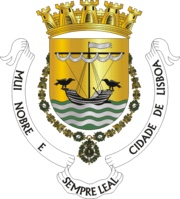
The motto “MUI NOBRE E SEMPRE LEAL CIDADE DE LISBOA” means – “most noble and always loyal city of Lisbon”.
We talk a little about modern day Lisbon and Portugal. Daniel does confirm that the country’s debt has been repaid in full to the IMF. He also told us that locals cannot afford to buy property in the inner city. The AirBnB phenomena has affected apartment prices and as previously mentioned, the city of Lisbon has put a moratorium on further transfers of apartment for rental purposes such as AirBnB, VRBO and others. Daniel also mentioned that Portugal has encouraged Europeans to purchase property here. He told us that if a French person buys property in Portugal they do not have to pay property taxes for 10 years. Another reason property prices are rising.
He tells us that Lisbon is the second oldest city in Europe (said to be four centuries older than Rome) as it was first discovered by the Phoenicians. Portugal is the country with the oldest borders (since 1143). I did read somewhere that Lisbon is “one of the oldest cities in Europe; so not too sure on being the second oldest.
Our first stop is the viewpoint at the Igreja (church) da Graca. The church as also known as “Our Lady of the Hill” because of its location. It is said to protect pregnant women. Daniel tells us that this small church used to be located in the Alfama area near the Castelo. It was not overly damaged by the earthquake, but the city made the decision to move the church to this area so it could overlook the city. I loved his expression; he told us the church was “legoed” here. In other words, taken apart and rebuilt on the hill.


We overlook the Graca, Alfama and Baixa areas. The word Baixa means “low or short” and is applicable as the neighbourhood of Baixa lies on the flats by the river Tagus. Alfama (where the Castelo de Sao Jorge is located) is the second oldest neighbourhood in Europe.
It’s funny in a way, I always think that tour guides could actually tell you anything and you would believe them. I always recall our time in Peru. Every time we encountered a local guide they would tell us that Peru has 500 kinds of different potatoes, the next guide would tell us 1,000 different kinds of potatoes and then 800 kinds. Robin and I always laugh about this fact.
Having said this, we will believe our guide Daniel and not do too much back checking will be done!
From this viewpoint we can also see in the distance the Ponte 25 de Abril which looks like the Golden Gate bridge. Apparently it was the same company that build this bridge as the Golden Gate. The bridge was commissioned by Salazar and was originally called Ponte Salazar. Daniel says commissioning the bridge is one of the few good things Salazar did during his time in power. The bridge was renamed after democracy was restored, which was on April 25th. A train runs along the lower part of the bridge.
In the distance we also see a large green area called the Parque Florestal de Monsanto. When we had seen this on the map, we assumed that upkeep/maintenance of the park was funded by Monsanto. It has nothing to do with the Monsato company; the park is located in the Monsanto hills, thereby its’ name. It is over 1,000 hectares (2,500 acres) and Daniel tells us that the locals refer to it as Lisbon’s lung due to all the trees that were replanted here after previous years of farming that had destroyed all the trees.
Our next stop is Sao Vicente de Fora which has a beautiful white facade built in the Renaissance style and it dominates the skyline of the area along with the Castelo. At the beginning of this post I referred to St. Vicente. It mentions that St. Vicente will be buried in the cathedral, but his remains are here. The interior of this church was quite beautiful.

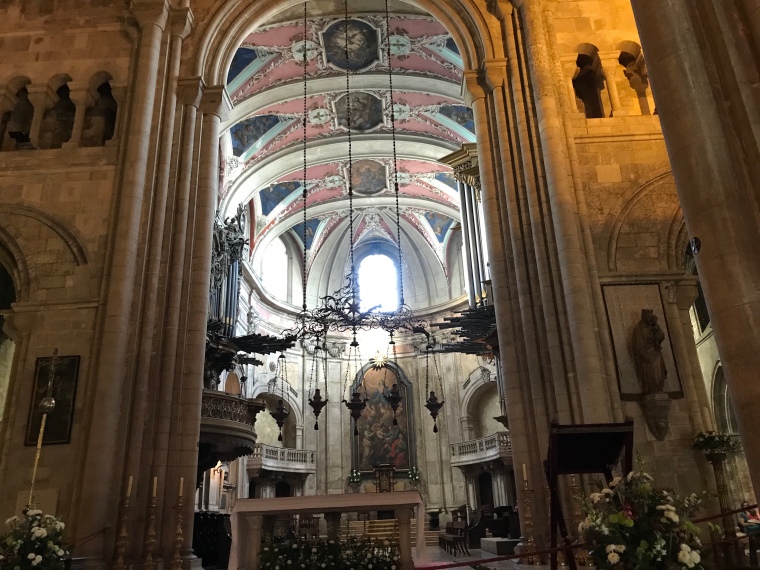
Continue our drive down the hill we pass along Marques street. Daniel tells us it is one of the only passages with no stairs, mainly a long ramp to get up the hill. The Tagus river used to reach the start of this street (now some 500 meters further out due to reclamation of land) and the boats would land here and the goods were taken up to the hills via the ramp, by horses and oxen.
Then we stop at the Se (Lisbon Cathedral) which was built in 1150 after the city was recaptured from the Moors. The cathedral was built on top of a mosque. We saw a lot of this in our travels last spring in the Andalusia province of Spain. The church has been rebuilt in part over the years due to tremors and the earthquake. The facade is quite simple and is framed by twin bell towers and a rose window in the middle. It almost looks like a fortress and our guide tells us it is built in the “primitive gothic” style. The guide book refers to the church as “simple and austere with a gloomy interior”. We did find it so. The Sao Vicente had a much more decorative interior.
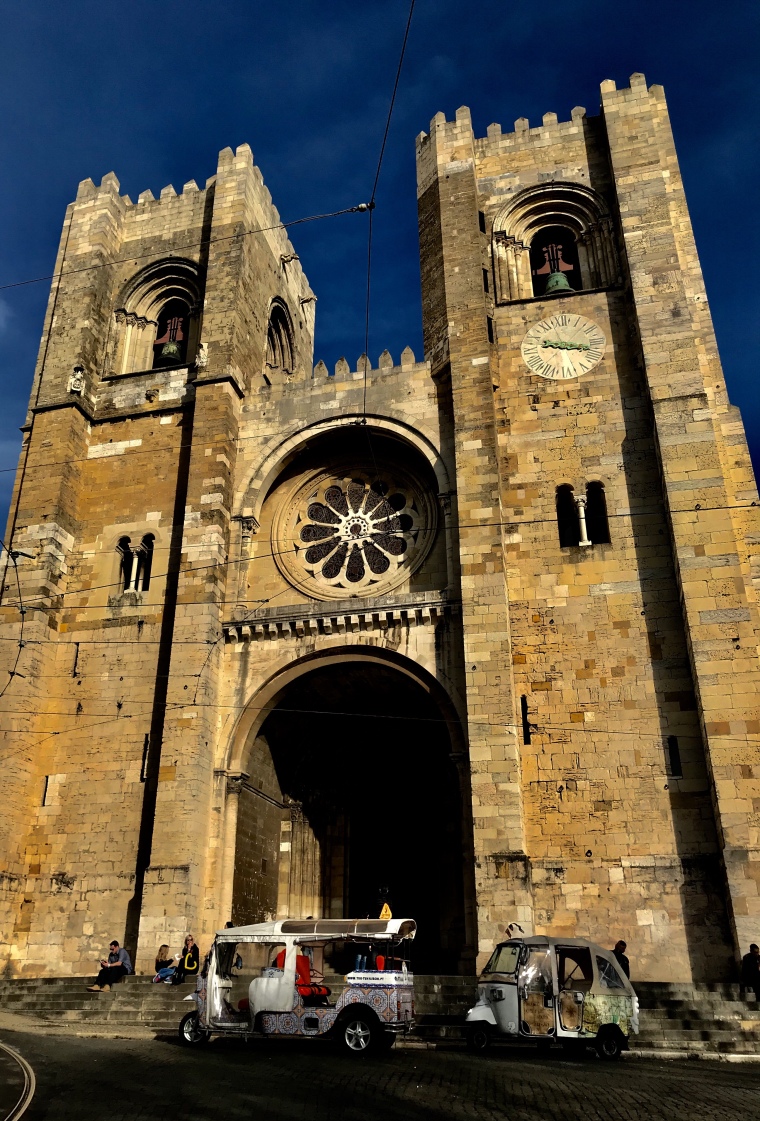

We pass by a small market, this location is where the Fiera de Ladra takes place twice a week. Really is a “flea” market and the locals refer to it as the “Thieves Market”. It has been operating for over a century. Don’t think we will bother returning here.
Daniel points out the light standards in the Baixa area and indeed we see the ship and the two crows, the symbol of Lisbon.
At one point, Daniel referred to an area which used to be a Jewish quarter, but hardly any Jewish people remaining here after their expulsion and or conversion during the time of the inquisitions. He also tells us that there is a Royal family in Portugal, but unlike other monarchs around the world, they keep a very low profile.
We make our way to Avenue da Liberdade and up to the Parque Eduardo V11. The park is called after Edward the V11 as this english monarch helped Portugal financially in the early 1900’s. What spectacular views down to the river. A beautiful monument in this location is a modern commemoration to the “carnation revolution”. This grassy slope runs uphill for 25 hectares (62 acres) from the Praca Marques de Pombal and is filled with beautifully clipped hedges. A botanical garden is located nearby.



We then head off to the Barrio Alto and Estrela districts. We stop at the small Sao Roque. This church looks quite simple from the outside but is quite ornate inside. Beautiful wood carvings. This church was founded by the Jesuits in the 16th century. The main church is surrounded by many altars and chapels. The Chapel of St. John is embellished with lapis lazuli, agate, alabaster, amethyst and several types of precious marbles, gold, silver and mosaics.
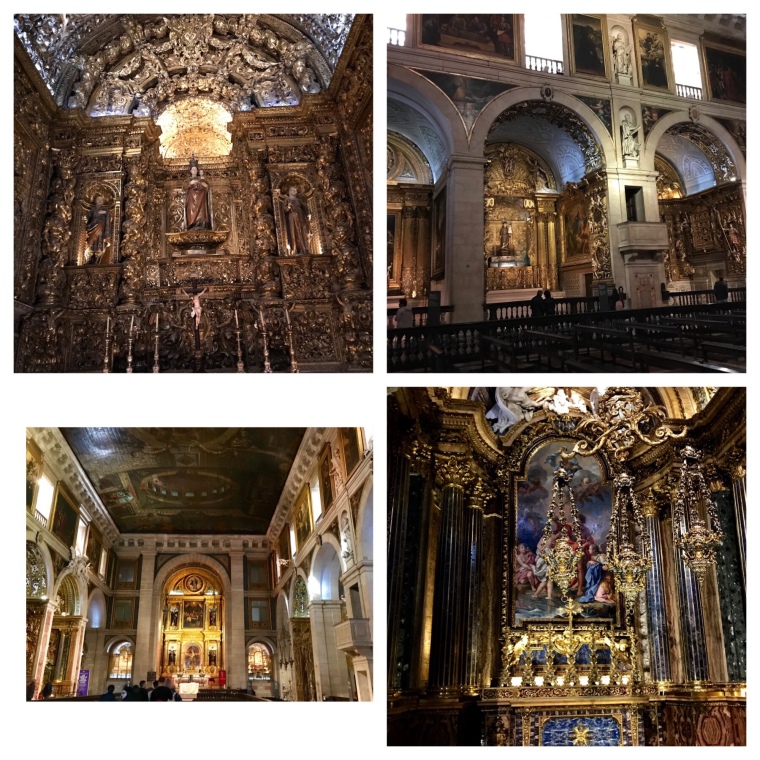
We pass by a monument to Luís Vaz de Camões, a poet, said to be the father of the Portuguese language.
We see tuk-tuks everywhere and when I asked our guide Daniel about these, he says that the locals think they are a real menace on the roads, especially in the height of the tourist season. The locals say they are too noisy, especially if they are gas powered. The city is looking to ban the gas powered tuk- tuks. Apparently they have been in Lisbon for a very long time and they are very handy in the narrow winding lanes. The drivers are always after the tourists to go for a tour. A good majority of them are now electric.
We are on our way to Belem and along the way, Daniel points out the LX Factory. This old factory is from 1846 and was refurbished in 2008 and he tells us we must stop by. Daniel says it is not as touristy as the Time Out Market, he feels a better option to visit. Apparently full of all types of shops from fashion, books, vintage furniture and many kiosks dedicated to food. We will need to visit.
When we arrive in Belem, Daniel stops by the Monastario, but since we have already visited, we pass on seeing it again. Daniel tells us that he is going to buy some Pasteis de Belem at the famous Antiga Confeitaria de Belém. Oh my gosh, the best custard tarts to date. I think I mentioned in my previous blog post that their custard tarts are called “pasteis de Belem” and not “pasteis de Nata”. Big difference I am told. There is a reference in a guide book to “nirvana”. Same recipe since 1837. The location is on the main street of Belem and there was a line up for those wanting takeout. We went in to look at the restaurant while Daniel was ordering. The restaurant sits 400, and you need to take a ticket and wait for a table. The place was jam packed with a line up of people inside, waiting for tables. I simply cannot imagine what this would be like in the height of the tourist season.
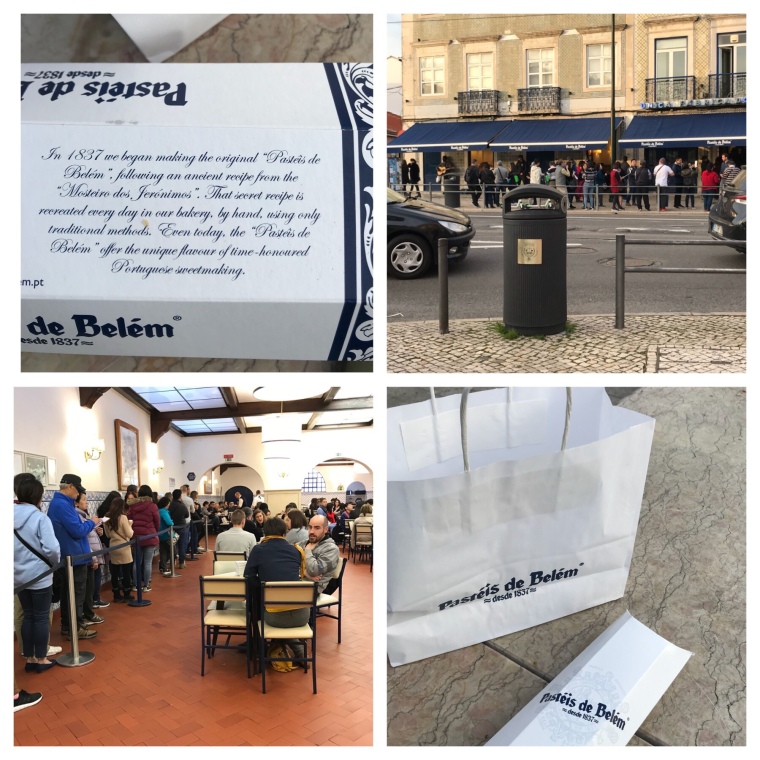
We drive by the Torre de Belem, but don’t stop here. We may come back on our own. This was the starting point for navigators who were setting out to discover the trade routes. Daniel tells us that at one time there was 10 fortresses similar to this one in the Tagus river from Lisbon to Cascais to guide the navigators. One has to remember that the river was much wider/higher than it is today. Daniel says that the tower was used as a torture chamber from 1941 to 1974.
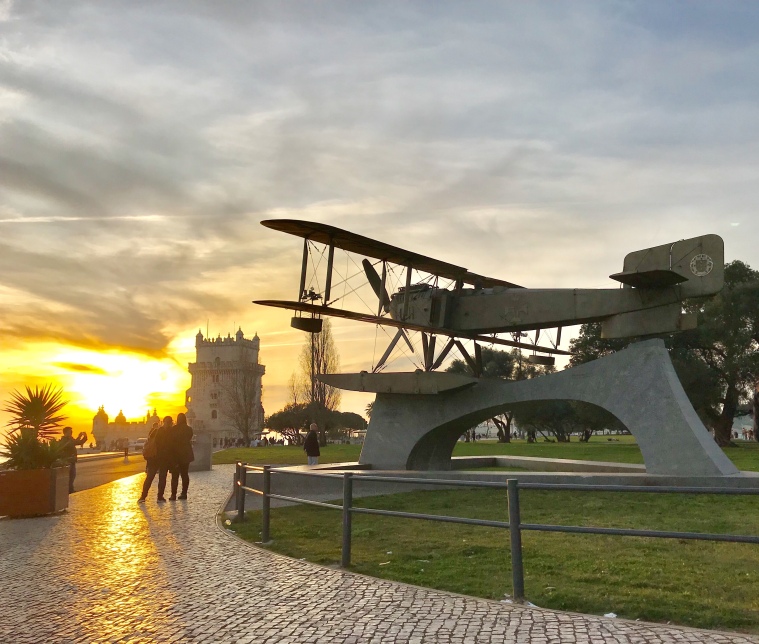
Our final stop of the day is the “Monument to the Discoveries” which is located along the river Tagus. The monument was built in 1960 to mark the 500th anniversary of the death of Henry the Navigator, who is at the head of the statue. The monument was commissioned by Salazar; Daniel says the only other good thing from Salazar’s reign. I particularly like the angular look of this monument and we had great late afternoon sunset to take pictures. The pavement around the monument is all in marble and inset is a map of the world and a huge compass which marks all the Portuguese discovery voyages, even Newfoundland in Canada.


A very informative day with Daniel who finally shares his best loved restaurants and other places/neighbourhoods to visit.
Today is Robin’s birthday and we have booked dinner at a restaurant recommended by the Manager of the apartment. We take an Uber to Tasca da Esquina and must say we certainly enjoyed our meal. I was tempted to take a picture of the small complimentary appetizers, the presentation was lovely….Robin wouldn’t let me, he said that was tacky. O.K., he is right…..just this time though! The appetizers consisted of a basket of various home made breads, a little jar of tuna pate, a round of soft cheese and some spiced olives. Robin ordered the Bachalau a Bras (shredded bits of salted cod, onions, chopped fried potatoes, all bound with scrambled eggs and garnished with black olives). I opted for fried squid and both dishes were excellent. I had booked the restaurant through “The Fork” which is the European counterpart of “Open Table” and I had mentioned in the comments that it was my husband’s birthday. When we walked in, the hostess and waiter both wished him Happy Birthday and we were given a complimentary glass of port at the end of our dinner.
Looked up what Bachalau a Bras means ; “The origin of the recipe is uncertain, but it is said to have originated in Bairro Alto, an old quarter of Lisbon. The name “Brás” (or sometimes Braz, Blaise in English) is supposedly the name of its creator. The “à Brás” technique is often used with other ingredients, such as vegetables and mushrooms.” So, now we all know.
This was a lovely evening out, we are eating most dinner’s at home. Having said this, we are not really cooking, but buying prepared meals from the various markets….hey, we are on holidays. Must say that our apartment is very comfortable. It is so well appointed and has all the amenities we need. So well stocked with all kinds of dishes. The bed is so comfortable which is so important. As we have rented for the month of February, a cleaning lady comes in once a week, very nice touch.
Our apartment is located on the main floor, so only a few stairs, which is great. The building has four floors. Our neighbour next door is an old portuguese lady. We have run into her a few times and we always smile. She tried to talk to us the other day, but she speaks no English and Robin tried Spanish, but not sure she understood. We basically just smile. We find it so funny, at times we hear her talking….sorry shouting, and we are not sure if she is talking on the phone or if she lives with someone (pity that person) or maybe just shouting at the cat. The shouting must be something common in older people here as we have heard this many times.
Normally we are having our lunch at restaurants, as we are usually out and about. We normally try to find small coffee shops and pastry shops as these are much more reasonably priced than restaurants and food is just as good. The odd glass of wine at lunch and must say that they have generous “pours” here.
Next Tuesday we are flying to Bilbao, Spain for a few days, as we have always wanted to visit the Guggenheim Museum. I have been looking for a tour company that will take us on a one day tour to San Sebastian, a town about one hour’s drive from Bilbao. Unfortunately it’s a four hour train trip, which just doesn’t make sense. It is one of those “can’t get there from here” situations. So far, the tour companies I have looked at, do not offer these trips until late March. There was one tour on a website “Be a Shepherd for a day”. I thought this was so funny, not sure what it would entail, but think we will pass on that one.
On Thursday, the 7th, we take the metro to the Museu Calouste Gulbenkian. Many of our friends told us this was a must see and they were right. We spent a few hours here enjoying the magnificent art works and the beautiful grounds. Calouste Gulbenkian was a wealthy Armenian oil magnate. The museum opened in 1969 and was specifically built to house his various art collections; which span centuries. Both Robin and I love sculptures and perhaps my favourite was the Lalique glass collection in one of the galleries. I read that Gulbenkian started his art collection at the age of 14, buying some ancient coins in a bazaar. He came to live in Portugal during WW11 and bequeathed his estate to the Portuguese via a charitable trust. Beautiful art, buildings and grounds.

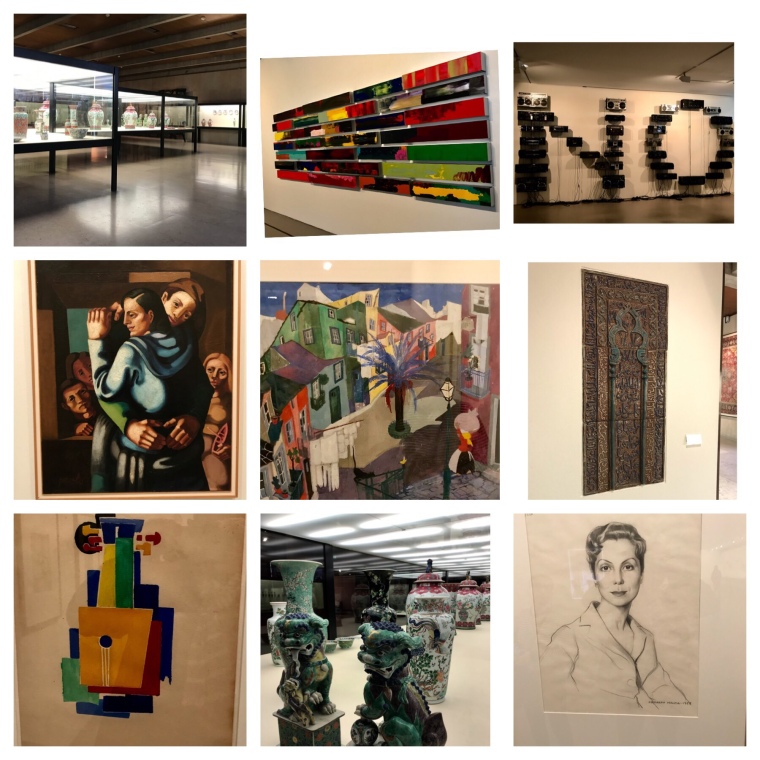


On Friday morning we head out to scout out a few places. Firstly, we head out to locate a Fado restaurant where we have a reservation on Saturday night. We know it is within walking distance and eventually find it in an alley which has many murals dedicated to Fado singers.

Next, an internet cafe so that we can print off some vouchers that are needed for a car transfer in Bilbao. Can’t understand why one can’t use vouchers on a phone, but oh well. We find an internet cafe just around the block from our apartment.
Today, we are doing something very touristy, but heh, I guess we are tourists! We are taking the famous yellow Tram 28. The starting point of this tram is just a few block away from us in Praca Martim Moniz, which is where we also catch the metro. There is already a line up of tourists waiting to catch the tram, but we are told that the trams come every 10 minutes or so. We only have to wait for the second tram to get on and we can use our metro cards. The route goes through the Graca neighbourhood and up the hill to the Alfama district where the Castelo and Se are located. It continues along where we can see good views of the city by some of the “miradouros”. Our tram was not too packed, so our views were pretty good. Once again, would not want to see how crammed these would be in the height of the tourist season. We did comment that there seemed to be more tourists around today and then we see a huge cruise boat at the port. In addition, it is the start of the weekend. The tram continues through the Baixa area and up to the Bairro Alto area and the trip finishes at Campo de Ourique. I have read that there is a market there, similar to the Time Out Market, so we must make this one of our day outings.

Some of the streets that the tram travel on are very narrow. Street lights control the two way traffic, as at times only room for one vehicle. Sometimes the tram is so close to the building, you could actually put your had out the window and touch them. I laughed, because at one point we passed an ATM machine in the wall. I said if we had stopped for traffic, I would have had enough time to reach down and get some cash!We get off the tram, then walk a few steps and get back on the 28 again, for our trip back. We decide to get off in the Baixa area and make our way back home.
 \
\
1
Saturday, February 9th and our objective is to go to an English used book store which is located in the outer area of the touristy section. The closest metro station to the bookstore is the only one in the system that is closed for renovations. Look into a bus option but really doesn’t work, so we use Uber. What a great service. We get to the Bookshop Bivar which I had found on the internet searching for used english bookstores. A tiny shop but a great selection of fiction upstairs and non-fiction in the basement. A young lady greets us in english and offers help, but we tell her we will just browse. She asks where we are from and she tells us that the owner is from Canada but born in the Azores. The owner comes up from downstairs when she hears our conversation, so we had a nice visit with her as well. We buy some books and are on our way.
Whenever we tell people here that Calgary is suffering with cold of -26, they simply can’t comprehend it. A lot of the locals have told us that the coldest temperatures that they have encountered are 0 or -5 Celsius. We have seen a lot of women wearing fur coats while we have been here. We think it is quite lovely, sunny and a high of 16 degrees today, usually around 9 or 10 degrees when we leave in the morning.
After the bookshop we go to one of the most famous coffee shops in Lisbon. The Cafe a Brasileira (The Brazilian Lady Cafe) was once the haunt of writers and intellectuals and is in the Chiado district. Beautiful interior and exterior; it was built in the 19th century. I think the name is a bit of a misnomer as the picture on the outside of the restaurant and on the menu is that of a grouchy looking man.
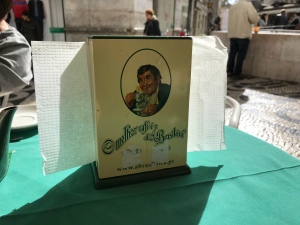
Interesting fact, if you have your coffee/tea outside it is more expensive than the interior of the cafe and less expensive again if you drink your coffee at the counter. We opt to have ours on the terrace outdoors and do some people watching.

Outside is a statue of Fernando Pessoa a famous 20th century Portuguese poet. I love these types of statues. A lot of people came by, while we were having coffee/tea and pastries outside, to sit next to the statue and have their pictures taken.

Walk around the Chiado neighbourhood and see some lovely buildings. A fire back in 1988 burnt a lot of the Chiado area. Apparently the fire engines were unable to enter the pedestrian streets so the fire spread and burnt a lot of shops. Fortunately during the reconstruction of the area, they were able to preserve some of the original facades of some of the buildings. If one takes the Santa Justa elevador from the Baixa area, it will deposit you up in the Chiado area.


On Saturday night, we booked a dinner at a restaurant just near us which included an evening of Fado music. A small house which has been converted into this restaurant called the “Maria da Mouraria”. It only had about 11 tables and last night it was full with about 30 people. If you recall, I had posted pictures of this alleyway earlier in this blog. Taken from the restaurant’s website “At the entrance of Rua do Capelão a sculpture of a Portuguese guitar announces Mouraria, the Cradle Of Fado. It is here where Casa da Severa (Maria Severa’s House) would have once stood. Severa, a woman who played the guitar and whose singing evoked pain and melancholy, as if she were singing of Fate, longing and disgrace, of loves and lovers lost. It was why people would say that Maria Severa “used to sing fado. ”
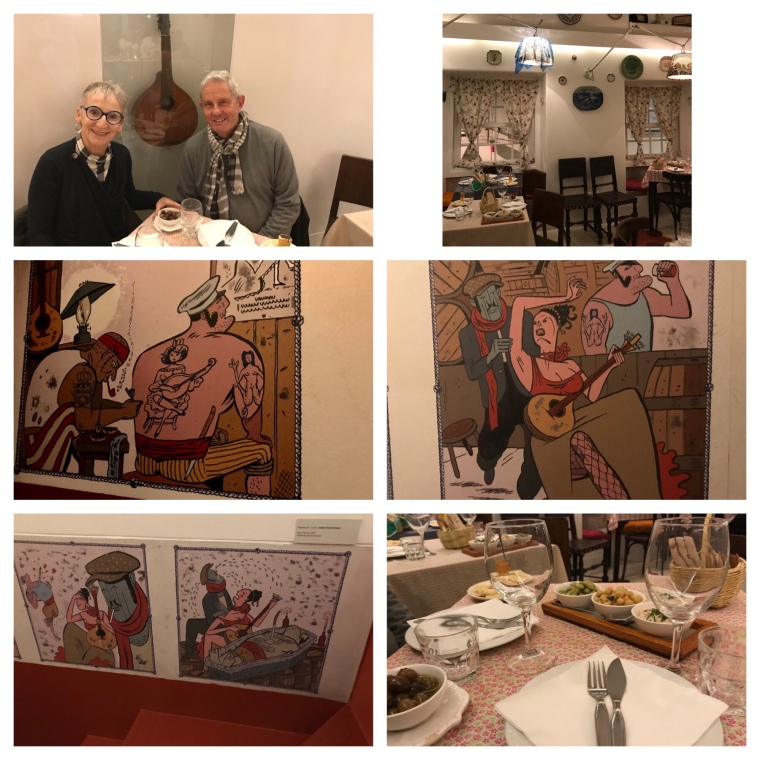
Our evening included a fixed menu which included appetizers, main entree, desert, wine, and coffee/tea. After our meal, the waiters came by and gave us a complimentary glass of “Ginjinhas” (ginja for short). Wikipedia tells us that “Ginjinha is a Portuguese liqueur that’s made from combining aguardente (brandy) and ginja berries, a sour type of cherry that’s known in English as a Morello Cherry.” It is served in a shot glass. I thought it was sweet and just ok, I still prefer a nice glass of port. He then offered us a glass of Muscatel, but with the non stop pouring of wine during the evening and the ginja, we passed on the Muscatel.
I apologize for the darkness of the following videos, but they put all the lights out when the entertainment started; only candles at the tables. Lovely ambience. This first video is the owner singing.
The entertainment started about 9 pm and we had just finished eating our dinner. The first set was two young men playing a Spanish guitar and the other must have been a Portuguese guitar, much smaller and more bulbous. One of them sang some Fado as well. About twenty minute till the next set, which featured the same two guitar players and an older woman.
She certainly sang from her soul, such a display of emotions. We were about ready to leave and the waiters told us we simply could not leave as the owner was about to sing. Glad we stayed, he was excellent. We left a little after 11 pm, but were told that the Fado went on till much later……way past our bedtime already.

One of the waiters insisted on walking us down to the end of the alley to the main square. From here we only had a five minute walk back to our apartment. When we said it wasn’t necessary to walk us to the square, they insisted saying that the neighbourhood was in “transition”. We haven’t found it to be a problem, although some men hanging around a few corners and bars near our apartment, we simply avoid these areas and if out late, usually take an Uber right to the door of our apartment. Other Fado restaurants had been recommended by the Manager of our apartment, but we opted for this one as reviews on Trip Advisor were descent, nearby and could book online. An absolutely wonderful evening. Good choice.
We had already decided to go the LX Factory on Sunday. We had seen this market during our tour on Wednesday and our guide told us a must see, especially on Sundays as they have artisans selling their wares. During the week, just the shops are open. LX Factory is simply that……a series of old buildings that have been “somewhat refurbished” to accommodate shops and restaurants. They had great murals everywhere you looked. We took the metro, then the train to get there. We followed some people that looked like they were headed to the market…..lo and behold, they were tourists as well and we had to walk an additional ten minutes around the complex to get inside.
This is a description of LX Factory from their website.
[“LX FACTORY
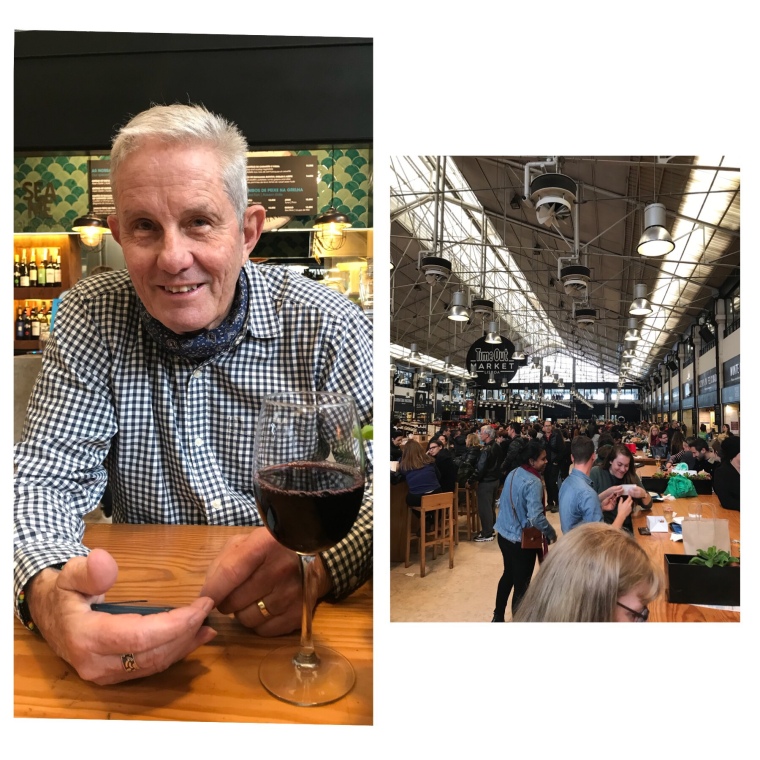

We are flying to Bibao, Spain late tomorrow afternoon and looking forward to our two days there.
I do apologize, a lot of you reading the blog may be seeing some of these pictures twice as Robin posts some on FaceBook.


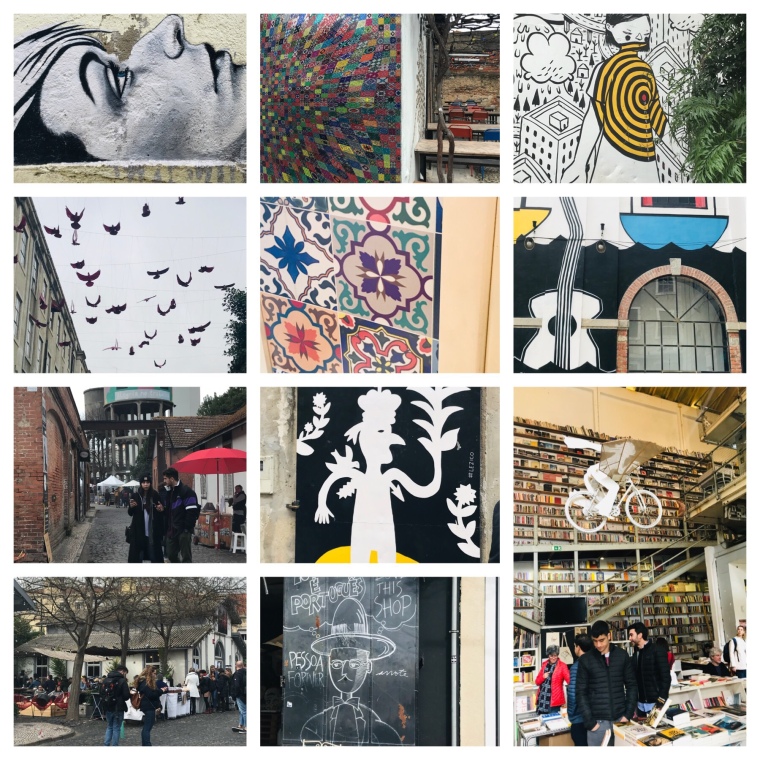

Thank you Claire for your wonderful account of this journey! I am treasuring all the moments.
LikeLike
Your trip sounds wonderful.
Xox
Susan
susancardinal@hotmail.com
LikeLike